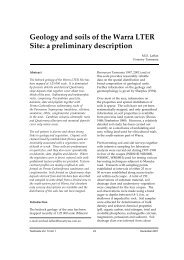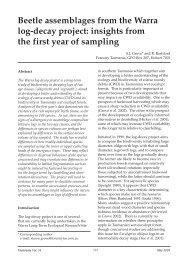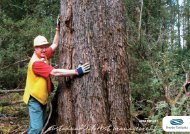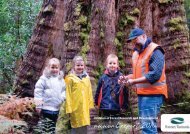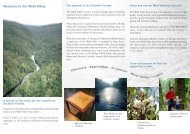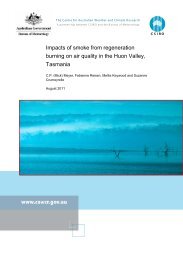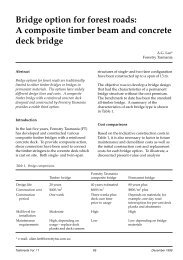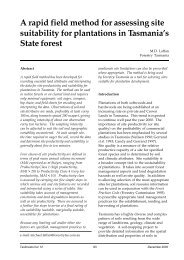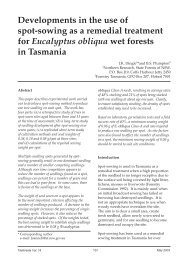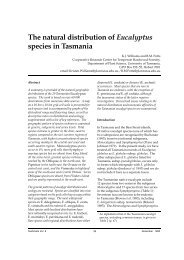annual report 2011 - Forestry Tasmania
annual report 2011 - Forestry Tasmania
annual report 2011 - Forestry Tasmania
You also want an ePaper? Increase the reach of your titles
YUMPU automatically turns print PDFs into web optimized ePapers that Google loves.
Biology and Conservation - Key research and development projects (continued)<br />
Sustainability Objective<br />
FT Staff and<br />
Collaborators<br />
Project name and aims 2010-11 Progress<br />
1. Sustain biodiversity and habitat<br />
1.4 Oldgrowth forests<br />
(cont.)<br />
S Grove<br />
A Phillips<br />
A Hingston<br />
Collaborators<br />
CRC for<br />
<strong>Forestry</strong><br />
SST Biodiversity<br />
Document the biodiversity impacts from the<br />
range of silvicultural treatments available for<br />
harvesting wet eucalypt forests.<br />
Completed <strong>annual</strong> bird and ground beetle surveys of the SST in the control<br />
and treatments that have reached 10-year post harvest (CBS + UI 1 and 2,<br />
DRN-2).<br />
T Wardlaw<br />
A Hingston<br />
Collaborators<br />
University of<br />
<strong>Tasmania</strong>,<br />
Oregon State<br />
University,<br />
Washington<br />
State<br />
University<br />
Forest influence<br />
Test the nature and magnitude of forest<br />
influence into harvest areas of old clearfells, and<br />
how influence effects vary dependent on the<br />
successional stage (wet sclerophyll versus mixed<br />
forest) of the adjoining retained forest.<br />
Liaised with overseas collaborators to participate in global meta-study to<br />
measure forest influence.<br />
Selected suitable sites and established 5 plots to measure forest influence<br />
in each of three clearfell, burn and sow age classes (5-10 year-old, 22-28<br />
year-old, 39-45 year-old).<br />
Tested sample of TFIC insects for their suitability for DNA barcoding.<br />
2. Sustaining jobs for current and future generations<br />
2.4 Plantations<br />
Establish and manage plantations<br />
to maintain timber supply levels<br />
to industry.<br />
T Wardlaw<br />
M Syme<br />
Dead branch defect in pruned plantations<br />
Understand the risk factors associated with<br />
branch trace defects developing after pruning<br />
dead branches and develop appropriate<br />
mitigation measures.<br />
Amended pruning prescription to reduce likelihood of branch trace defect<br />
following pruning of dead branches.<br />
18




